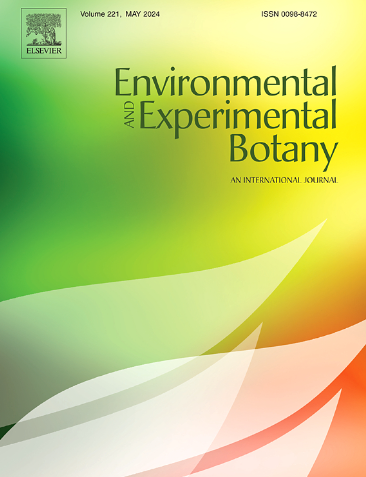Comparative transcriptome and co-expression network reveals key genes associated with mesocotyl elongation in foxtail millet (Setaria italica)
IF 4.7
2区 生物学
Q2 ENVIRONMENTAL SCIENCES
引用次数: 0
Abstract
Mesocotyl elongation characteristics decisively influence the emergence rate and deep-sowing tolerance of gramineous crops. However, there is limited research on the mechanism of mesocotyl elongation in foxtail millet under deep sowing conditions. To address this research gap, 119 foxtail millet accessions were used to analyze genetic diversity. Moreover the long mesocotyl variety Qinhuang 2 (Q) and the short mesocotyl variety Dungu 1 (D) were screened for pot experiments under different deep-sowing conditions (6, 8, and 10 cm) to investigate the relationship between seedling emergence ability and mesocotyl elongation. Mesocotyl tissues at a 10 cm sowing depth for two to six days were subjected to transcriptome sequencing and determination of endogenous hormone content. RNA-sequencing (RNA-Seq) was used to analyze the transcriptional mechanism of mesocotyl elongation under deep-sowing conditions, highlighting the key genes influencing several plant characteristics. The mesocotyl lengths of 119 foxtail millet materials exhibited a normal distribution and were divided into five groups, with the length decreasing from Group 1 to Group 5. Under deep-sowing conditions, the emergence rate of the long-mesocotyl variety Q was much higher than that of the short-mesocotyl variety D. The results indicate that under deep-sowing conditions, mesocotyl elongation is the main driving force for pushing the plumule through the soil surface. The endogenous IAA and ACC contents were significantly higher in the long mesocotyl variety Q than in the short mesocotyl variety D. When 10 µmol/L of IAA and 200 mg/L of ethephon were applied, the mesocotyls of both varieties were elongated. In contrast, the ABA content was the opposite, and no significant difference was observed in GA3, indicating that IAA and ETH play a key role in the elongation of the mesocotyl of foxtail millet. In the co-expression network analysis, four related genes were identified in each of the “brown” and “purple” modules that were positively correlated with mesocotyl elongation. The expression levels of auxin-responsive proteins (IAA1, IAA17, and SAUR36) and ethylene genes EBF1 and EIL3 in Q were higher than those in D and increased with the elongation of the mesocotyl. Transcription factors MYC2, TGAL6, and PIF4 were involved in mesocotyl elongation. The “yellow” module was negatively correlated with mesocotyl elongation and contained transcription factors ERF, WRKY, and TGA2. Notably, by analyzing the levels of endogenous hormones and phenotypes, the expression patterns of the hub genes IAA17 and IAA1 have been found to be consistent with mesocotyl growth and show an overall upward trend. These findings provide insights into understanding the mechanism of mesocotyl elongation and highlight their potential application value in breeding foxtail millet to resist deep sowing.
比较转录组和共表达网络揭示谷子中胚轴伸长相关关键基因
中胚轴伸长特性对禾科作物出苗率和耐深播性具有决定性影响。然而,对深播条件下谷子中胚轴伸长的机理研究较少。为了弥补这一研究空白,利用119份谷子材料进行遗传多样性分析。筛选长中胚轴品种秦黄2号(Q)和短中胚轴品种敦谷1号(D),在不同深播条件(6、8和10 cm)下进行盆栽试验,研究出苗能力与中胚轴伸长的关系。在10 cm播种深度2 - 6天对中胚轴组织进行转录组测序和内源激素含量测定。利用RNA-Seq技术分析了深播条件下中胚轴伸长的转录机制,揭示了影响植株若干性状的关键基因。119份谷子材料的中胚轴长度呈正态分布,分为5组,从第1组到第5组,中胚轴长度依次递减。在深播条件下,长中胚轴品种Q的出苗率远高于短中胚轴品种d。结果表明,在深播条件下,中胚轴伸长是推动胚轴穿过土壤表面的主要动力。长中胚轴品种Q的内源IAA和ACC含量显著高于短中胚轴品种d。当IAA浓度为10µmol/L,乙烯利浓度为200 mg/L时,两个品种的中胚轴均被拉长。而ABA含量则相反,GA3含量差异不显著,说明IAA和ETH在谷子中胚轴伸长中起关键作用。在共表达网络分析中,“棕色”和“紫色”模块各鉴定出4个与中胚轴伸长正相关的相关基因。生长素响应蛋白(IAA1、IAA17和SAUR36)和乙烯基因EBF1和EIL3在Q中的表达量高于D,且随着中胚轴的延长而升高。转录因子MYC2、TGAL6和PIF4参与中胚轴伸长。“黄色”模块与中胚轴伸长呈负相关,包含转录因子ERF、WRKY和TGA2。值得注意的是,通过分析内源激素水平和表型,我们发现枢纽基因IAA17和IAA1的表达模式与中胚轴生长一致,整体呈上升趋势。这些研究结果为了解中胚轴伸长机制提供了新的思路,并在谷子抗深播育种中具有潜在的应用价值。
本文章由计算机程序翻译,如有差异,请以英文原文为准。
求助全文
约1分钟内获得全文
求助全文
来源期刊

Environmental and Experimental Botany
环境科学-环境科学
CiteScore
9.30
自引率
5.30%
发文量
342
审稿时长
26 days
期刊介绍:
Environmental and Experimental Botany (EEB) publishes research papers on the physical, chemical, biological, molecular mechanisms and processes involved in the responses of plants to their environment.
In addition to research papers, the journal includes review articles. Submission is in agreement with the Editors-in-Chief.
The Journal also publishes special issues which are built by invited guest editors and are related to the main themes of EEB.
The areas covered by the Journal include:
(1) Responses of plants to heavy metals and pollutants
(2) Plant/water interactions (salinity, drought, flooding)
(3) Responses of plants to radiations ranging from UV-B to infrared
(4) Plant/atmosphere relations (ozone, CO2 , temperature)
(5) Global change impacts on plant ecophysiology
(6) Biotic interactions involving environmental factors.
 求助内容:
求助内容: 应助结果提醒方式:
应助结果提醒方式:


